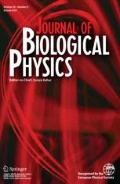Abstract
Yeast cells approach a mating partner by polarizing along a gradient of mating pheromones that are secreted by cells of the opposite mating type. The Bar1 protease is secreted by a-cells and, paradoxically, degrades the α-factor pheromones which are produced by cells of the opposite mating type and trigger mating in a-cells. This degradation may assist in the recovery from pheromone signaling but has also been shown to play a positive role in mating. Previous studies suggested that widely diffusing protease can bias the pheromone gradient towards the closest secreting cell. Here, we show that restricting the Bar1 protease to the secreting cell itself, preventing its wide diffusion, facilitates discrimination between equivalent mating partners. This may be mostly relevant during spore germination, where most mating events occur in nature.



Similar content being viewed by others
References
Falke, J.J., Bass, R.B., Butler, S.L., Chervitz, S.A., Danielson, M.A.: The two-component signaling pathway of bacterial chemotaxis: a molecular view of signal transduction by receptors, kinases, and adaptation enzymes. Annu. Rev. Cell Dev. Biol. 13, 457–512 (1997)
Eichmann, A., Makinen, T., Alitalo, K.: Neural guidance molecules regulate vascular remodeling and vessel navigation. Genes Dev. 19, 1013–1021 (2005)
Barkai, N., Rose, M.D., Wingreen, N.S.: Protease helps yeast find mating partners. Nature 396, 422–423 (1998)
Bardwell, L.: A walk-through of the yeast mating pheromone response pathway. Peptides 25, 1465–1476 (2004)
Valtz, N., Peter, M., Herskowitz, I.: FAR1 is required for oriented polarization of yeast cells in response to mating pheromones. J. Cell Biol. 131, 863–873 (1995)
Duntze, W., MacKay, V., Manney, T.R.: Saccharomyces cerevisiae: a diffusible sex factor. Science 168, 1472–1473 (1970)
Cross, F., Hartwell, L.H., Jackson, C., Konopka, J.B.: Conjugation in Saccharomyces cerevisiae. Annu. Rev. Cell Biol. 4, 429–457 (1988)
Segall, J.E.: Polarization of yeast cells in spatial gradients of alpha mating factor. Proc. Natl. Acad. Sci. U. S. A. 90, 8332–8336 (1993)
Taxis, C., Keller, P., Kavagiou, Z., Jensen, L.J., Colombelli, J., Bork, P., Stelzer, E.H., Knop, M.: Spore number control and breeding in Saccharomyces cerevisiae: a key role for a self-organizing system. J. Cell Biol. 171, 627–640 (2005)
Ballensiefen, W., Schmitt, H.D.: Periplasmic Bar1 protease of Saccharomyces cerevisiae is active before reaching its extracellular destination. Eur. J. Biochem. 247, 142–147 (1997)
Chan, R.K., Otte, C.A.: Physiological characterization of Saccharomyces cerevisiae mutants supersensitive to G1 arrest by a factor and alpha factor pheromones. Mol. Cell. Biol. 2, 21–29 (1982)
Hicks, J.B., Herskowitz, I.: Evidence for a new diffusible element of mating pheromones in yeast. Nature 260, 246–248 (1976)
Manney, T.R.: Expression of the BAR1 gene in Saccharomyces cerevisiae: induction by the alpha mating pheromone of an activity associated with a secreted protein. J. Bacteriol. 155, 291–301 (1983)
Crank, J.: The Mathematics of Diffusion, 1st edn. Oxford University Press, London (1956)
Ghaemmaghami, S., Huh, W.K., Bower, K., Howson, R.W., Belle, A., Dephoure, N., O’Shea, E.K., Weissman, J.S.: Global analysis of protein expression in yeast. Nature 425, 737–741 (2003)
Yi, T.M., Kitano, H., Simon, M.I.: A quantitative characterization of the yeast heterotrimeric G protein cycle. Proc. Natl. Acad. Sci. U. S. A. 100, 10764–10769 (2003)
Bajaj, A., Celic, A., Ding, F.X., Naider, F., Becker, J.M., Dumont, M.E.: A fluorescent alpha-factor analogue exhibits multiple steps on binding to its G protein coupled receptor in yeast. Biochemistry 43, 13564–13578 (2004)
Schandel, K.A., Jenness, D.D.: Direct evidence for ligand-induced internalization of the yeast alpha-factor pheromone receptor. Mol. Cell. Biol. 14, 7245–7255 (1994)
Moukadiri, I., Jaafar, L., Zueco, J.: Identification of two mannoproteins released from cell walls of a Saccharomyces cerevisiae mnn1 mnn9 double mutant by reducing agents. J. Bacteriol. 181, 4741–4745 (1999)
Endres, R.G., Wingreen, N.S.: Accuracy of direct gradient sensing by single cells. Proc. Natl. Acad. Sci. U. S. A. 105, 15749–15754 (2008)
Berg, H.C., Purcell, E.M.: Physics of chemoreception. Biophys. J. 20, 193–219 (1977)
Jenness, D.D., Burkholder, A.C., Hartwell, L.H.: Binding of alpha-factor pheromone to Saccharomyces cerevisiae a cells: dissociation constant and number of binding sites. Mol. Cell. Biol. 6, 318–320 (1986)
Frykman, S., Srienc, F.: Quantitating secretion rates of individual cells: design of secretion assays. Biotechnol. Bioeng. 59, 214–226 (1998)
Frykman, S., Srienc, F.: Cell cycle-dependent protein secretion by Saccharomyces cerevisiae. Biotechnol. Bioeng. 76, 259–268 (2001)
Velculescu, V.E., Zhang, L., Zhou, W., Vogelstein, J., Basrai, M.A., Bassett, D.E. Jr., Hieter, P., Vogelstein, B., Kinzler, K.W.: Characterization of the yeast transcriptome. Cell 88, 243–251 (1997)
Singh, A., Chen, E.Y., Lugovoy, J.M., Chang, C.N., Hitzeman, R.A., Seeburg, P.H.: Saccharomyces cerevisiae contains two discrete genes coding for the alpha-factor pheromone. Nucleic Acids Res. 11, 4049–4063 (1983)
Finkelstein, D.B., Strausberg, S.: Metabolism of alpha-factor by a mating type cells of Saccharomyces cerevisiae. J. Biol. Chem. 254, 796–803 (1979)
Ciejek, E., Thorner, J.: Recovery of S. cerevisiae a cells from G1 arrest by alpha factor pheromone requires endopeptidase action. Cell 18, 623–635 (1979)
Maness, P.F., Edelman, G.M.: Inactivation and chemical alteration of mating factor a by cells and spheroplasts. Proc. Natl. Acad. Sci. U. S. A. 75, 1304–1308 (1978)
Beckett, A., Illingworth, R.F., Rose, A.H.: Ascospore wall development in Saccharomyces cerevisiae. J. Bacteriol. 113, 1054–1057 (1973)
Acknowledgements
We thank Prof. Andrew Murray for insightful comments and suggestions and members of our group for discussions. This work was supported by the NIH (P50GM068763), the European Research Council, the Israel Science Foundation, Minerva, and the Hellen and Martin Kimmel Award for Innovative Investigation.




